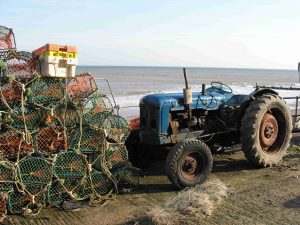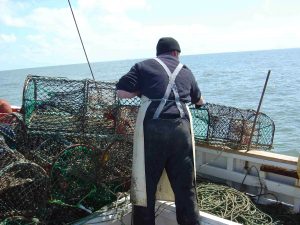Potting
 Crustacean shellfisheries are of high importance in the Eastern IFCA District, forming the main catch for many of the fishermen along the North Norfolk coast, where crab and lobster are targeted from Spring to late Autumn off the Norfolk coast and in The Wash. In Suffolk and off the Lincolnshire coast, there are potting fisheries which are predominantly targeted in the summer months. In addition to the well-known European lobster (Homarus gammarus) and brown or edible crab (Cancer pagurus), fishermen also target the velvet swimming crab (Necora puber) and fish offshore for whelk (Buccinum undatum).
Crustacean shellfisheries are of high importance in the Eastern IFCA District, forming the main catch for many of the fishermen along the North Norfolk coast, where crab and lobster are targeted from Spring to late Autumn off the Norfolk coast and in The Wash. In Suffolk and off the Lincolnshire coast, there are potting fisheries which are predominantly targeted in the summer months. In addition to the well-known European lobster (Homarus gammarus) and brown or edible crab (Cancer pagurus), fishermen also target the velvet swimming crab (Necora puber) and fish offshore for whelk (Buccinum undatum).
There are two broad categories of potter. The inshore beach-boat is small, open to the elements and generally crewed by one or two fishermen. These boats tend to fish very close inshore, often within sight of land. Although many have motorised pot-haulers fitted, there are still some fishermen who hand-haul their pots. Visitors to Cromer and Sheringham in the summer can see examples of these smaller potters being launched and recovered from the beach by tractor.
 The mobile potters can still be relatively small – some are under 10 metres long – although they tend to be larger than this. They are equipped with a covered wheelhouse, a large deck and often a sorting table as well as a pot hauler. These bigger boats can go much further afield and target fisheries further offshore, staying out for longer – generally ten hours or more, leaving harbour on one tide and returning on the next.
The mobile potters can still be relatively small – some are under 10 metres long – although they tend to be larger than this. They are equipped with a covered wheelhouse, a large deck and often a sorting table as well as a pot hauler. These bigger boats can go much further afield and target fisheries further offshore, staying out for longer – generally ten hours or more, leaving harbour on one tide and returning on the next.
Parlour pots are the most common gear, and on the offshore grounds are used more or less exclusively. While traditional pots are said to do very well with a regular turnover (being hauled every day or so), they will not retain their catch indefinitely, and so are not efficient if the gear is to be left for longer periods of time. Here, parlour pots excel: once inside the pot, the crab or lobster must enter a second chamber (parlour) to get to the bait; this is set up in such a way that it is easy to enter but very difficult to leave. Parlour pots are larger than traditional pots, usually made of metal and plastic, fitted with nylon netting. They are often left in the water for five or more days before the fisherman revisits that string of pots to collect the catch and re-bait.
